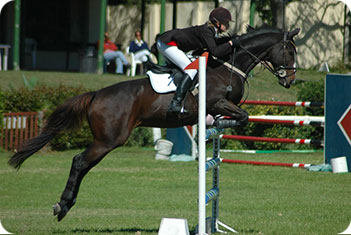Before you start jumping of any kind, you must master the two point position. This is basically your jumping position, what you do over a jump to make things more comfortable for your horse and to make sure you don't fall off.
This is what it looks like:
 |
| Credit to http://www.artofriding.com |
 |
| Credit to http://americashorsedaily.com |
My two point position is a little different from the pictures, so I'll give you some tips.
- You want to put all your weight in your stirrups and rise out of the saddle, but you don't want to rise so much that it looks like your trying to stand up. You only need to rise enough out of the saddle to get out of the horses way so they can jump the jump.
- Make sure you shorten your stirrups before you jump. You want your stirrups a few holes higher than normal so you can be balanced over the jump.
- When you go into two point, ideally you want to be able to draw a straight line from your head to shoulder to knee to toe.
- When you jump, you want to give your a horse some release. Beginners are usually taught a crest release, which is basically just sliding your hands forward up your horse's neck. This is so that you are not pulling back hard on the horses mouth and making it harder for him to jump. Some horses also use their neck for momentum, so it's important to give them some release. Make sure you aren't putting your hands too far forward though- you still want to have a light contact with the horse's mouth.
- Make sure your lower leg doesn't slide back- you want your leg to be close to the girth. It's a common problem for a rider's leg to slide back. It is often caused when a saddle doesn't fit properly, when a rider grips to much with their knees, when their stirrups are too long or when they don't put enough weight in their heels. Remember- heels down!
- When you start bigger jumps, you want to make sure that you bend a lot at the hips, like this:
 |
| This rider has a good amount of bend in her hips for bigger jumps. pic from http://www.equestrianandhorse.com |
Last but not least, don't go into your jumping position too early. Try and let the horse push you up into two point. If you anticipate the jump too much and go into two point early, your horse might refuse and you'll fly right over his head! That's all the tips I have- Good luck jumping!
